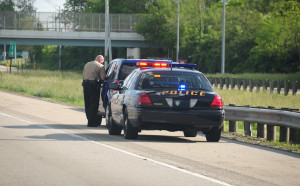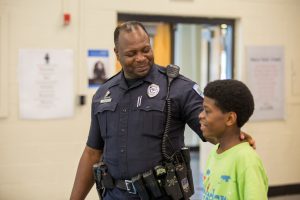Real or Fake Cops?: Police Departments SHOULD Take the Initiative!
Posted by Extreme Tactical Dynamics on Jun 29th 2019
When motorists see the flashing red and blue of police lights in the rear-view mirror, they naturally assume that a real law enforcement officer is signalling them to pull over and to stop, but in more and more cases both in the United States and abroad, that is NOT the case. And with the number of incidents involving fake cops on the rise, how can a motorist, especially a woman alone, be sure if the officer is legitimate? Sometimes it’s hard to tell because wrongdoers have access to all types of equipment that give the appearance of being ‘the real thing.’
What can police departments do? Well, in Oregon, the State Police have taken the matter of ‘fake’ cops so seriously that they have put together a comprehensive list of tips that help motorists identify who is pulling them over. The basics are emphasized like keeping the engine running and turning on the emergency flashers. The list of ‘DON’TS’ continues: Never open the window all the way, and NEVER get out of the vehicle. Oregon officers assure motorists that bona fide police will ALWAYS ask for the driver’s license, registration, and proof of insurance. In addition, there is a list of more valuable ‘tips’ that inform a driver what to look for, what to ask the officer, and most importantly what to do if you believe the person who stopped you is a fake.
IMPERSONATING AN OFFICER HAS NO BOUNDARIES
 There are so many accounts of law enforcement impersonations globally that this crime can easily be labeled as rampant! In countries as far apart as Thailand and the the UK, there are newspaper reports of those who are ‘caught in the act.’ In a few cases, the perpetrator has no malicious intent, like ‘Sergeant Eros’ in the UK, a stripper, who was pulled over on his way to work and fined for wearing the uniform and for carrying unauthorized gear on his police belt. But like those incidents in the U.S.A., most look-a-likes have not only committed the crime of impersonation but have also robber, assaulted, and even killed their victims. Unfortunately, in almost every case, the public had NOT been previously warned about an impersonator in their midsts. It is usually only after an incident occurs that a local newspaper may interview someone from a police department and write an article about what to do if someone is unsure about who is flashing lights behind them.
There are so many accounts of law enforcement impersonations globally that this crime can easily be labeled as rampant! In countries as far apart as Thailand and the the UK, there are newspaper reports of those who are ‘caught in the act.’ In a few cases, the perpetrator has no malicious intent, like ‘Sergeant Eros’ in the UK, a stripper, who was pulled over on his way to work and fined for wearing the uniform and for carrying unauthorized gear on his police belt. But like those incidents in the U.S.A., most look-a-likes have not only committed the crime of impersonation but have also robber, assaulted, and even killed their victims. Unfortunately, in almost every case, the public had NOT been previously warned about an impersonator in their midsts. It is usually only after an incident occurs that a local newspaper may interview someone from a police department and write an article about what to do if someone is unsure about who is flashing lights behind them.
REPORTING AFTER THE FACT
In 2014, the Journal Sentinel in Milwaukee reported such an encounter and informed its readers what to look for. In this case,a woman who was traveling alone at 10:45 at night noticed that a ‘police’ vehicle was following too close when flashing its lights. She pulled over sensing something was not right. Once the ‘officer’ got out of his vehicle, his mannerisms gave him away. The lady cracked the window and told him she was calling 911 for a police dispatcher to verify his presence. At that, he jumped into his car and sped away.
The article tells readers to activate the emergency flashers, drive the speed limit to a well-lit place then goes on to tell them what to do. But shouldn’t this information be readily taught prior to an individual’s potential assault? Shouldn’t the public be made aware of ways to secure their safety BEFORE they make such an encounter?
BEST CASE SCENARIO
Time and again, one of the most common types of ‘stops’ reported is of a woman who is traveling alone, and all too often things don’t turn out well. It’s good, however, to report that in March of this year an impersonator failed to entrap his prey. The incident occurred in Plainfield, Illinois, a suburb of Chicago, when a woman was leaving a pizza place. Fortunately, for her, the popular place was well lit, so when the imposter asked for I.D. and offered NOT to give her a ticket if she gave him her phone number, she didn’t hesitate to call his bluff. This is one incident that did end in a warning to the general public to watch out for someone who ‘looked like’ a local officer, but didn’t have the right patch on his uniform, as she had observed.
What is shown clearly by this incident is that when people keep their wits about them and carefully ‘check out’ the attire, equipment, badges, etc. of the person who has detained them, they have the advantage. Police departments everywhere have a real opportunity to educate and protect those they serve on how to detect fakers.
PROGRAMS IN SCHOOLS AND FOR THE PUBLIC
 In-school programs conducted by local police officers would reach all the children and not just the few whose parents saw an article in a newspaper. And while children are always instructed not to talk to strangers and what to do if a strange person approaches them, they could easily be fools by someone who looks like a law enforcement officer. Officers should conduct assemblies that focus on the ‘things’ for children to look for if a stranger tells them that they are a police officer. Nothing is more effective than a face to face assembly program in a school. Police departments through community liaison groups and volunteers can easily organize learning experiences that reach both adults and children in a community.
In-school programs conducted by local police officers would reach all the children and not just the few whose parents saw an article in a newspaper. And while children are always instructed not to talk to strangers and what to do if a strange person approaches them, they could easily be fools by someone who looks like a law enforcement officer. Officers should conduct assemblies that focus on the ‘things’ for children to look for if a stranger tells them that they are a police officer. Nothing is more effective than a face to face assembly program in a school. Police departments through community liaison groups and volunteers can easily organize learning experiences that reach both adults and children in a community.
Police Departments, through special programs, should inform and instruct the public with well-publicized seminars and community programs, but that doesn’t seem to be happening. Kids are easy victims of those posing as police officers. It was AFTER an incident in Utah when an eight year old was sexually assaulted that the Unified Police Department of Kearns offered a few tips for parents to discuss with their children, but is that enough?
PROTECT YOUR LOVED ONES NOW with WIKI-HOW...DON’T WAIT!
There are just a few programs that address this pervasive problem, and it takes a lot of time to create new ones. So, until these programs are organized by local police departments, there is an easy-to-watch presentation by Wikihow that gives detailed information telling how to tell a real cop from a fake one. While it is created for adult motorists, there is a section that children can benefit from, too, which shows the attire, badges, and equipment carried by legitimate officers. When children can see what gear looks like, they will be better prepared to make the correct identifications. Motorists will not have to think twice about what to look for once they have seen this helpful slide show.
What is more, the presentation can also be used as a guide by police departments to help them organize programs for the community. It covers ALL the tactics that should be used when trying to make sure the person in uniform is ‘legit!’
An OUNCE of PREVENTION….
This old adage holds true, like never before especially now when police impersonators are ever increasing. Everyone must be made aware of the sinister game, their fake vehicles, their fake uniforms, and their fake gear. Too often, the intimidation factor kicks in when motorists see flashing emergency vehicle lights, but take the time to carefully observe who is pulling you over. Children should be taught to be careful when talking to strangers no matter how official they look. Police Departments should make it a top priority to educate and protect those they serve. Take the time NOW to make the public aware of the predators and/or pranksters who are posing as real police officers.
Police Departments...take the initiative! Why wait until after an incident occurs to tell the public what they should have looked for?
References:
Safety Tip: Police Impersonatorswww.oregon.gov/osp/PATROL/Pages/Safety-Tip---Police-Impersonators.aspx
How to Spot Someone Impersonating a Police Officerhttp://www.wikihow.com/Spot-Someone-Impersonating-a-Police-Officer
Tips to Help Kids Spot a Fake Cophttp://wchstv.com/news/local/police-offer-tips-on-how-to-spot-a-fake-cop
Related Posts
- Can Civilians Use Police Flashing Lights?
- FIRST RESPONDERS AND KIDS at the HOLIDAY SEASON
- The Perfect Holiday Gift for your First Responder
- Blazing Infernos – California, Oct. 2017
- K9 Police Officers and their Dogs
- IACP 2017 is Just Around the Corner
 Facebook
Twitter
Google+
Instagram
YouTube
Facebook
Twitter
Google+
Instagram
YouTube

